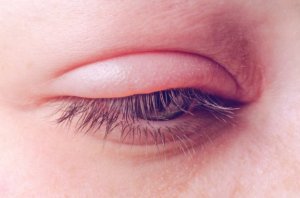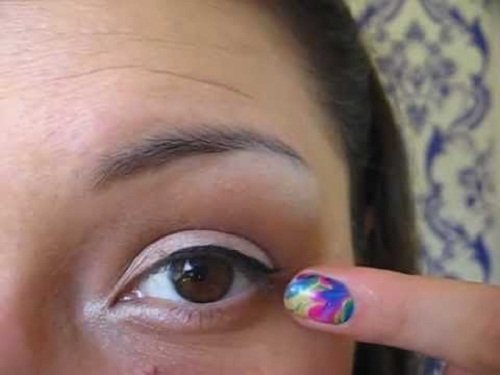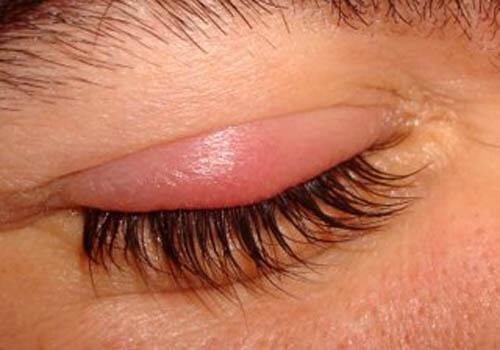Blepharitis: Causes, Symptoms and Treatment

Blepharitis is inflammation of the edge of the eyelid.
In order to understand this condition, it’s important to remember that there are several glands responsible for secreting substances at the edge of the eyelid. Some of these glands product fat. This type is called Meibomian glands, and issues with these glands is the most common cause of Blepharitis.
When something blocks the Meibomian glands, they can’t drain like they need to. Therefore, bacteria on the skin grows.
As a general rule, this conditions affects both patients’ eyelids. Usually, it affects the part where eyelashes grow. This is because that’s where most of the Meibomian glands are.
Currently, blepharitis is one of the most common vision problems. It affects both men and women equally. In addition, it can appear at any point in the patient’s life.
The Most Common Symptoms

Generally, patients with this disorder have a few common symptoms. For example, the most common symptoms are:
- Sensitivity to light (photosensitivity).
- Red or watery eyes. Patients may also have dry eyes if the glands that keep them hydrated are blocked.
- Swelling in the eyelids. Additionally, they may tend to look reddish and greasy.
- The need to blink frequently, as well as stinging or discomfort. Patients often say that it feels like they have sand in their eyes.
Other common symptoms may also include:
- Changes in eyelashes. In general, there may be a lot of eyelashes that start growing in the wrong direction.
- Dry and peeling skin around the eyes and on the eyelids. If the problem persists over time, it could form long-term scars.
- Hard, crusty substances in the morning around the eyes.
- Styes. These are lumps at the base of eyelashes. Usually, they’re the result of an infection, and generally cause discomfort.
- Lumps. When there’s an infection in the sebaceous glands, a lump forms that includes both the external and internal parts of the eyelid. In this case, it becomes inflamed and turns red.
- Chronic pink eye.
- Problems in the cornea from irritation of this layer or other related injuries.
Maybe you’re interested in: 7 Recommendations to Fight Pink Eye Naturally
Possible Causes of Blepharitis

Currently, specialists aren’t sure what the exact causes are of this disorder. However, specialists say that there are a number of factors that trigger Blepharitis.
The most common causes are:
- Something blocking the eyelids’ sebaceous glands. Usually, a bacterial infection causes this alteration.
- Seborrheic dermatitis or other skin disorders like rosacea.
- The presence of mites, lice, or other living things on eyelashes that might damage this region.
- Allergic reactions to eye compounds such as medication, makeup, etc.
The Best Treatments for Blepharitis
First, doctors will need to diagnose your condition as Blepharitis. A medical team will use a serious of tests to do so.
Next, they will determine the best treatment options for each case.
Some of the most common therapeutic methods are:
- Treating the underlying problem. This is particularly helpful for patients with rosacea and seborrheic dermatitis.
- Antibiotic drugs to treat bacterial infections in the sebaceous glands. Usually, you apply them locally with drops or creams. Also, you can take them orally.
- Anti-inflammatory drugs to reduce swelling in your eyes. Generally, these come in the form of drops or ointments.
- Using eye drops for patients with dry eyes.
- Antihistamines if the trigger is an allergy.
Check it out: What You Need to Know About Ibuprofen
Care and Hygiene
Another important treatment is personal care. You can do this two to four times a day, and it consists of the following steps:
- Place a compress or wet gauze on your eyelids for a few minutes. This way, the crust will come off easily when you remove them with a new damp cloth.
- Then, clean the edges of your eyelids by rubbing them gently with another compress with water.
- Finally, rinse with lots of warm water. To dry the area correctly, gently stroke with a clean towel.
All cited sources were thoroughly reviewed by our team to ensure their quality, reliability, currency, and validity. The bibliography of this article was considered reliable and of academic or scientific accuracy.
- Bernardes, T. F., & Bonfioli, A. A. (2010). Blepharitis. Seminars in Ophthalmology. https://doi.org/10.3109/08820538.2010.488562
- Turnbull, A. M. J., & Mayfield, M. P. (2012). Blepharitis. BMJ (Online). https://doi.org/10.1136/bmj.e3328
- Duncan, K., & Jeng, B. H. (2015). Medical management of blepharitis. Current Opinion in Ophthalmology. https://doi.org/10.1097/ICU.0000000000000164
- Lindsley, K., Matsumura, S., Hatef, E., & Akpek, E. K. (2012). Interventions for chronic blepharitis. In Cochrane Database of Systematic Reviews. https://doi.org/10.1002/14651858.CD005556.pub2
- Putnam C. M. (2016). Diagnosis and management of blepharitis: an optometrist’s perspective. Clinical optometry, 8, 71–78. https://doi.org/10.2147/OPTO.S84795
This text is provided for informational purposes only and does not replace consultation with a professional. If in doubt, consult your specialist.








